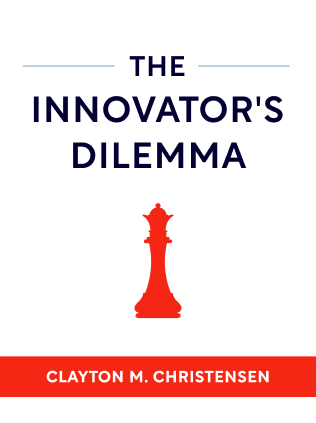

This article is an excerpt from the Shortform summary of "The Innovator's Dilemma" by Clayton M. Christensen. Shortform has the world's best summaries of books you should be reading.
Like this article? Sign up for a free trial here .
What is The Innovator’s Dilemma by Clayton Christensen? How does the book explain the potential benefits and challenges of innovation?
The Innovator’s Dilemma by Clayton Christensen is a book that presents the choice faced by companies seeking to innovate. They can continue responding to current customers’ needs or they can do something large and disruptive, changing the market completely.
Keep reading to find out more about the key concepts in The Innovator’s Dilemma by Clayton Christensen.
Concepts in The Innovator’s Dilemma by Clayton Christensen
Most companies achieve success by responding to what their customers want and consistently pursuing higher profits. However, when confronting certain innovations, these strategies that help companies thrive under normal circumstances instead can lead to their demise.
These kinds of innovations—called disruptive innovations—don’t come along very often, but when they do, they change how companies make and market products, the types of customers who buy them, and how they use them. The Innovator’s Dilemma by Clayton Christensen explains how to recognize disruptive innovations, why they cause industry-leading organizations to fail, and how to avoid the same fate.
Upward Mobility and Downward Immobility
Successful companies typically focus on growing and moving upmarket with higher-priced products, higher-tier customers, and larger profits. However, this upward mobility makes firms downwardly immobile—it impedes them from adopting disruptive innovations, which always start downmarket.
Established companies face three key barriers to downward mobility according to The Innovator’s Dilemma by Clayton Christensen:
- Cost structures that favor seeking higher profit margins upmarket over cutting costs to remain profitable downmarket. Large, successful companies have high overhead costs that require large profit margins. Most companies find it impossible to bring in enough profits from existing products while also trimming overhead enough to invest in low-profit disruptive products.
- Organizational cultures that pull efforts toward upmarket projects. Companies have processes that weed out low-profit projects—but they also steer companies away from disruptive technologies, making the firms vulnerable to being overtaken by the disruption.
- The upmarket drift of a company’s customers and competitors. Companies drift upmarket when their customers are pursuing higher markets themselves—they demand bigger products because they want to offer more to their own customers—and when their competitors are similarly leaning upmarket to meet customers’ needs. As companies move upmarket, they create openings in lower value networks for entrants to move in with disruptive products.
How to Weather Disruptive Innovations According to The Innovator’s Dilemma by Clayton Christensen
After Clayton Christensen’s The Innovator’s Dilemma outlined the factors that cause established firms to fail when confronting disruptive innovations, we’ll talk about how managers can avoid falling into these traps.
Established firms generally struggle to survive disruptive innovations, but if managers understand the governing principles of disruptive technologies, they can weather the storm or, at best, harness them for their success. Companies that don’t know what they’re up against or how to navigate it will almost surely succumb to disruptive technology’s takeover.
Company Resources
The theory of resource dependence states that managers don’t control how resources are spent—customers and investors do, because their interests determine the company’s success.
Problem: Successful companies are adept at weeding out ideas and projects that customers don’t want. However, disruptive technologies are inherently unappealing to current customers—at least, initially. By the time the disruptive technology has improved enough to attract the company’s customers, entrant companies have already established their dominance and expertise in making the product.
Solution: Generally, the only way for an established company to successfully invest in a disruptive technology is to create a separate operation that is independent of the company’s core business and is solely focused on developing the disruptive technology. This separate entity must be able to develop its own cost structure, and it should have the benefit of the parent company’s resources.
Small Markets
Companies are pressured to continually grow, and, the bigger they get, the more profits they need to cover increasing costs. If two companies both need to sustain 20 percent growth rates, but one is a $40 million company and the other is a $4 billion company, the larger company faces greater pressure to gain $800 million in new sales compared to the smaller company’s $8 million.
Problem: The emerging markets for disruptive innovations are too small to support large companies’ growth needs. But if big companies wait until the disruptive technology’s market is established enough to better satisfy their growth needs, they miss the critical window for entry and are less likely to succeed with the disruptive product.
Solution: When a company creates an independent organization to lead its production of a disruptive technology, that organization must be small enough to match the small, emerging market for the new technology.
Unknown Markets
Most companies and managers make strategies, plans, and decisions based on analyses of market trends and projections based on those trends. Using this data, managers make detailed plans for executing new projects.
Problem: This approach doesn’t work for disruptive technologies, because disruptive products sell to markets that didn’t previously exist, so there are no data to measure past patterns or make projections about future needs. Exacerbating the problem is the fact that success in disruptive innovations favors companies that move quickly—so companies must act fast, but they have little information to create a plan of action.
Solution: When launching disruptive products, companies should make strategies and plans around learning, not executing. Managers must acknowledge what they don’t know, identify what data they need, and in what order they need it.
Additionally, Clayton Christensen in The Innovator’s Dilemma says companies should:
- Assume forecasts are wrong.
- Plan—and budget—for multiple product iterations and marketing strategies.
- Learn from how customers behave with disruptive products, rather than what they say they want.
Capabilities in Context
Established firms become successful by developing certain capabilities that help them to efficiently and profitably develop, market, and sell their goods or services. Each company’s capabilities are specific to its product and the value networks.
An organization’s capabilities consist of three things:
- Resources, such as people, money, technology, knowledge, customers, and relationships with suppliers and distributors.
- Processes, such as patterns of communication, coordination, and decision-making that employees use to create the company’s products and services.
- Values, which dictate how the company and its employees make prioritizing decisions.
Problem: Companies typically need an entirely different set of capabilities to develop disruptive products than they do to produce existing ones. For example, a disruptive product may require a company to source component parts from suppliers, but the company has few contacts because it manufactures the component parts for all of its existing products.
According to Clayton Christensen in The Innovator’s Dilemma, it’s nearly impossible to shift an entire organization’s ingrained processes and values. As a result, the capabilities that make an established firm successful in an existing market become disabilities in adapting to a disruptive technology.
Solution: Spin-out or acquire an independent organization, which can develop the processes and values it needs to produce the disruptive technology.
Newest Technological Advances
According to The Innovator’s Dilemma by Clayton Christensen, technology often advances more rapidly than customers’ demand for bigger, better, faster products.
Problem: When companies aren’t in tune with their customers’ needs, they continually update their products with new features and performance improvements—and the prices reflect the upgrades. Customers don’t always want the very best; they just want good enough to get the job done.
This performance oversupply creates an opening for disruptive technology to forge a place in the market. Disruptive products that meet customers’ needs and offer lower prices, convenience, and more simplicity can edge existing products—and established firms—out of the market.
Solution: Companies that face performance oversupply have three options:
- Climb upmarket, continually adopting sustaining technologies and pursuing higher-tier customers, while leaving lower-tier customers open for disruptive innovations. This is the course most companies take.
- Keep pace with customers, meeting their needs even as their focus shifts from functionality to reliability to convenience to price. This is difficult to do successfully, for reasons we’ve mentioned (for example, companies’ processes and values impede them from producing lower-cost products).
- Leverage marketing to make customers want higher-performing products. However, it’s unclear how long a company can sustain this approach before a lower-tier disruptive product invades the market.
Any of these strategies can work if a company executes it with a clear understanding of the trajectories of its customers’ needs and of the technological advancements.
—
As seen in The Innovator’s Dilemma by Clayton Christensen, disruptive innovations can cause companies to fail despite—and even because of—prudent business practices, such as listening to customers and pursuing high-profit markets.
However, leaders of established companies can find hope in the fact that solving the innovator’s dilemma isn’t a matter of working harder or making smarter decisions. Successfully navigating a disruption in your industry is simply a matter of understanding when you’re confronting a disruptive technology and how to handle it.

———End of Preview———
Like what you just read? Read the rest of the world's best summary of Clayton M. Christensen's "The Innovator's Dilemma" at Shortform .
Here's what you'll find in our full The Innovator's Dilemma summary :
- Christensen's famous theory of disruptive innovation
- Why incumbent companies often ignore the disruptive threat, then move too slowly once the threat becomes obvious
- How you can disrupt entire industries yourself






